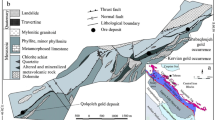Abstract
The extraction of spectral signature through remote sensing data in geological studies is very limited in Indian terrain. The present research is an attempt to delineate alteration and associated minerals using high resolution multispectral advanced space borne thermal emission and reflection (ASTER) data in Sakoli volcano-sedimentary sequence. The alteration zones are generally associated with certain types of mineral and mineral aggregates and are localized in the ground that can be mapped remotely using spectral mapping techniques. The band ratio and selective PCT were applied on calibrated ASTER image to extract spectral signature of index mineral. The results showed that high abundance of these minerals within pixels is corresponding to the alteration zones. The field observation, petrography and XRD analysis of the alteration zones confirmed the presence of dominant mineral phases that were identified remotely.
Similar content being viewed by others
References
Abdelsalam, M.G., Stern, R.G. and Berhane, W.G. (2000) Mapping gossans in arid regions with Landsat TM and SIR-C images: the Beddaho Alteration zone in northern Eritrea. Jour. African Earth Sci., v.30(4), pp.903–916.
Crosta, A.P., Sabine, C. and Taranik J.V. (1998) Hydrothermal alteration mapping at Bodie, California, Using AVIRIS hyperspectral data. Remote Sensing Environ., v.65, pp.309–319.
Crosta, A.P. and Moore, J. (1989) Enhancement of Landsat Thematic Mapper imagery for residual soil mapping in SW Minais Gerais State, Brazil: a prospecting case history in Greenstone Belt Terrain. In: Proc. 7th (ERIM) Thematic Conference: Remote Sensing for exploration geology, Environmental Research Institute of Michigan, Ann Arbor, MI, USA, 24, pp.1173–1187.
Crowley James, K. (1986) Visible & near-infrared spectra of carbonate rocks: Reflectance variations related to petrographic texture & impurities. Jour. Geophys. Res., v.91, pp.5001–50012.
Envi (2009) Atmospheric Correction Module: QUAC and FLAASH User’s Guide; http://www.exelisvis.com/portals/0/pdfs/envi/Flaash_Module.pdf.
Ferrier, G., Et Al. (2002) The mapping of hydrothermal alteration zones on the island of Lesvos, Greece using an integrated remote sensing dataset. Internat. Jour. Remote Sensing, v.23(2), pp..341–356.
Galvao, L.S., Filho, R.A. and Vitorello, C. (2005) Spectral discrimination of hydrothermal altered materials using ASTER Shortwave infrared bands, Evaluation in a tropical Savannah Environment. Internat. Jour. Appld. Earth Observ. Geoinfor., v.7, pp.107–114.
Harsanyi, J.C. (1993) detection and classification of sub pixel spectral signatures in Hyperspectral image sequences. PhD dissertation, University of Maryland, Baltimore country, 116p.
Hunt, G.R. and Ashley, P. (1979) Spectra of altered rocks in the visible and near infrared. Econ. Geol., v.74, pp.1613–1629.
Loughlin, W. (1991) Principal component analysis for alteration mapping. Photogrammetric Engineering and Remote Sensing, v.57, pp.1163–1169.
Rown, L.C., Schmidt, R.G. and Mars, J.C. (2006) Distribution of hydrothermally altered rocks in Reko Diq, Pakistan mineralized area based on spectra analysis of ASTER data. Remote Sensing of Environment, v.104, pp.74–87.
Rowan, L.C., Mars, J.C. and Simpson, C.J. (2005) Lithologic mapping of the Mordor, NT, Australia ultramafic complex by using the advanced spaceborne thermal emission and reûection radiometer (ASTER). Remote Sensing of Environment, v.99, pp.105–126.
Roy, A., Bandopadhyay, B.K., Huin,A.K., Mony, P.C.D. and Saha, S.K. (1995) Geology of the Sakoli Fold Belt Nagpur, Bhandara and Gadchiroli dts., Central India. Final Report on the Geological mapping, Unpub. Prog. Rept. Geol. Surv. India.
Sabine, C. (1999) Remote sensing strategies for mineral exploration. In: A.N. Rencz (Ed.), Remote Sensing for Earth Sciences: Manual of Remote Sensing, (New York: John Wiley and Sons, Inc), pp.375–447.
Tangestani, M.H. Et Al., (2008) Evaluating Advanced Spaceborne Thermal Emission and Reflection Radiometer (ASTER) data for alteration zone enhancement in a semiarid area, northern Shahr-e-Babak, SE Iran. Internat. Jour. Remote Sensing, v.29, pp.2833–2850.
Author information
Authors and Affiliations
Corresponding author
Rights and permissions
About this article
Cite this article
Ghosh, U.K., Naik, K.K. & Kesari, M.P. Digital image processing of multispectral ASTER imagery for delineation of alteration and related clay minerals in Sakoli belt: Maharashtra – A case study. J Geol Soc India 88, 464–470 (2016). https://doi.org/10.1007/s12594-016-0509-3
Received:
Accepted:
Published:
Issue Date:
DOI: https://doi.org/10.1007/s12594-016-0509-3




